Welcome to our article on Echinodorus Red Flame, a stunning aquatic plant that adds a vibrant touch to any freshwater aquarium.
Its bold red foliage stands out as a focal point in a planted tank. In this article, we will explore the characteristics, care, and maintenance of the Echinodorus Red Flame, as well as its role in the aquarium ecosystem.
When it comes to creating a captivating underwater landscape, Echinodorus Red Flame is an excellent choice.
Its fiery red leaves inject a pop of color and bring life to any planted tank. Whether you’re an experienced aquarist or a beginner, this freshwater plant offers beauty, simplicity, and versatility.
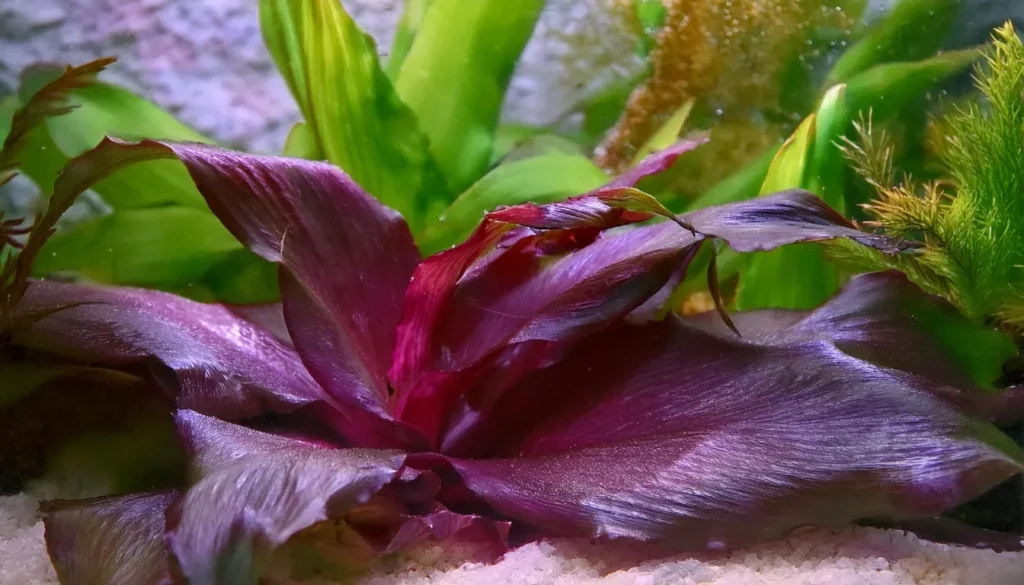
Key Takeaway
- Echinodorus Red Flame is a stunning aquatic plant with bold red foliage.
- It adds vibrant color and becomes a focal point in a planted tank.
- This freshwater plant is easy to care for and suitable for beginners.
- Echinodorus Red Flame contributes to the overall aesthetics and functionality of an aquarium.
- By releasing oxygen and absorbing excess nutrients, it helps maintain water quality and provides a natural habitat for fish and other aquatic creatures.
Quick Stats
| Attribute | Details |
| Scientific Name | Echinodorus ‘Rubin’ |
| Common Name | Echinodorus Red Flame, Red Rubin Sword |
| Origin | Cultivated hybrid, precise origin may vary |
| Height | 20-30 cm (8-12 inches) |
| pH Range | 6.5 – 7.5 |
| CO2 Requirement | Low to Medium |
| Growth Rate | Moderate |
| Care Level | Easy to Moderate |
| Color Form | Vibrant red, may deepen under high light conditions |
| Water Conditions | 22-28°C (72-82°F), soft to moderately hard water |
| Max Size | Typically remains within the stated height range |
| Lighting | Moderate to High |
| Supplements | Root tabs or liquid fertilizers beneficial |
| Placement | Background |
| Propagation | Through division of rhizome or adventitious plantlets |
What Is Echinodorus Red Flame?
This plant, a member of the Echinodorus genus, is commonly referred to as a sword plant.
It originates from Central and South America and thrives in various aquatic environments such as rivers, streams, and swamps.
Renowned for its vibrant red foliage, this plant has become increasingly popular among aquascaping enthusiasts due to its eye-catching aesthetics and ease of care.
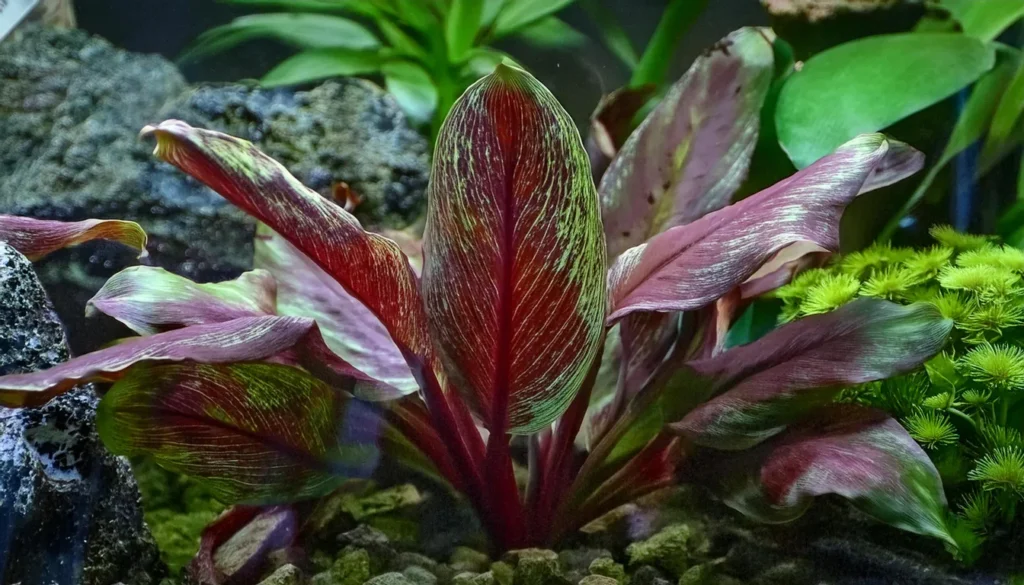
The Origin And Popularity Of Echinodorus Plants In Aquascaping
- Echinodorus plants, including the Red Flame variety, have gained significant popularity in the world of aquascaping.
- Their origins in Central and South America appeal to aquarists looking to recreate natural environments within their tanks.
- Echinodorus plants thrive in various water conditions and are appreciated for their hardiness and adaptability.
- With a diverse range of shapes, sizes, and colors, they provide aquascapes with ample options to create visually stunning and dynamic aquatic landscapes.
RELATED: Cryptocoryne Wendtii Green Planting Guide For Beginners
Characteristics Of Echinodorus Red Flame
- Echinodorus is characterized by its bold red foliage, a focal point in any aquarium. It typically grows to a height of 12-16 inches and showcases long and narrow leaves.
- Its vibrant color adds depth and dimension to the overall aesthetics of a planted tank. With its striking appearance and hardy nature, Echinodorus Red Flame is an excellent choice for those looking to create a visually captivating aquascape.
Light Requirements For Optimal Growth
- Echinodorus Red Flame requires moderate to high levels of light to thrive. Adequate lighting is essential as it enables these plants to undergo photosynthesis and produce the energy they need for growth.
- Providing the right amount and intensity of light will help maintain the vibrant red foliage of the Echinodorus Red Flame.

Temperature And Placement On A Planted Tank
- Echinodorus Red Flame thrives in temperatures ranging from 70-82°F, which is suitable for most tropical fish. Maintaining a consistent temperature within this range will ensure your Red Flame’s optimal growth and health.
- Additionally, proper placement of the plant in your planted tank is essential. Consider the height and spread of the Red Flame as it grows to ensure it does not overshadow or overcrowd other plants in your aquascape.
- By strategically positioning your Echinodorus Red Flame, you can create a visually balanced and harmonious aquatic environment.
| Temperature Range | Placement |
| 70-82°F | Strategic placement that accounts for height and spread |
Optimal Water Condition
- Temperature: Aim for a temperature range of 72°F to 82°F (22°C to 28°C). This range provides the warmth necessary for robust growth and overall health.
- pH Level: Maintain a pH level between 6.5 and 7.5. Echinodorus Red Flame can tolerate slightly acidic to slightly alkaline conditions within this range.
- Water Hardness: Keep the water hardness (GH) between 4 to 15 dGH (degrees of General Hardness) and the carbonate hardness (KH) between 3 to 8 dKH (degrees of Carbonate Hardness). These levels ensure that the water provides essential minerals while remaining stable.
- Lighting: Provide moderate to high lighting. Echinodorus Red Flame thrives under moderate to high light conditions. Aim for around 8 to 10 hours of light per day, using full-spectrum LED or fluorescent lights with a color temperature around 6500K.
- CO2: While not strictly necessary, CO2 supplementation can benefit Echinodorus Red Flame, especially in high-tech planted aquarium setups. CO2 injection can promote lush growth and vibrant coloration.
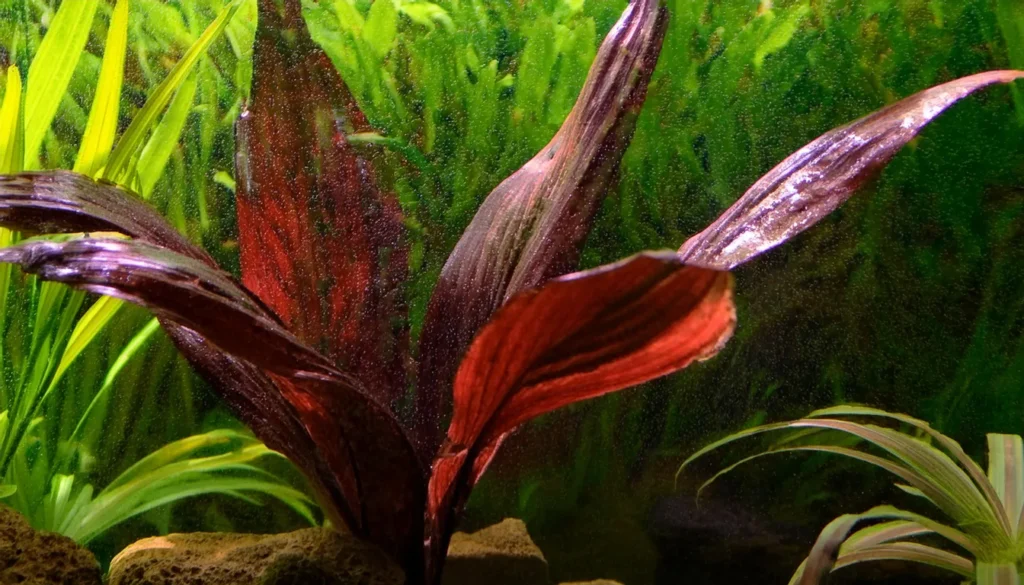
Substrate Requirements
- Nutrient-Rich Substrate: Echinodorus Red Flame benefits from a nutrient-rich substrate that provides essential minerals and nutrients for healthy growth. Choose a substrate specifically formulated for planted aquariums, such as aquasoil, nutrient-rich gravel, or clay-based substrates. These substrates typically contain a blend of macro and micronutrients to support plant growth.
- Depth: The substrate depth should be sufficient to anchor the plants securely and provide ample space for root development. Aim for a substrate depth of at least 2 to 3 inches (5 to 7.5 centimeters) to ensure adequate coverage and stability.
- Granule Size: Select a substrate with an appropriate granule size that allows for proper root penetration and prevents compaction. Fine-grained substrates may compact over time, restricting root growth, while coarse substrates may allow for better water circulation and root development.
- Fertilization: While a nutrient-rich substrate provides a solid foundation for plant growth, additional fertilization may be necessary, especially in heavily planted aquariums or if the substrate nutrients become depleted over time. Supplement with root tabs or liquid fertilizers as needed to ensure continuous nutrient availability.
Placement Options
- Background Plant: Echinodorus Red Flame can be placed in the background of the aquarium to create a stunning focal point. Its tall and broad leaves provide a striking backdrop for smaller plants or fish in the mid-ground or foreground.
- Mid-Ground Plant: If you have a large aquarium, you can place Echinodorus Red Flame in the mid-ground to add depth and visual interest to the aquascape. Position it between foreground plants and background decorations to create a balanced composition.
- Group Planting: Plant several specimens of Echinodorus Red Flame together to create a dense group or cluster. This can create a more impactful visual effect and mimic the appearance of a natural stand of plants in the wild.
- Solitary Specimen: Alternatively, you can showcase a single specimen of Echinodorus Red Flame as a standalone focal point in the aquarium. Place it off-center to create visual asymmetry and draw attention to its vibrant red foliage.
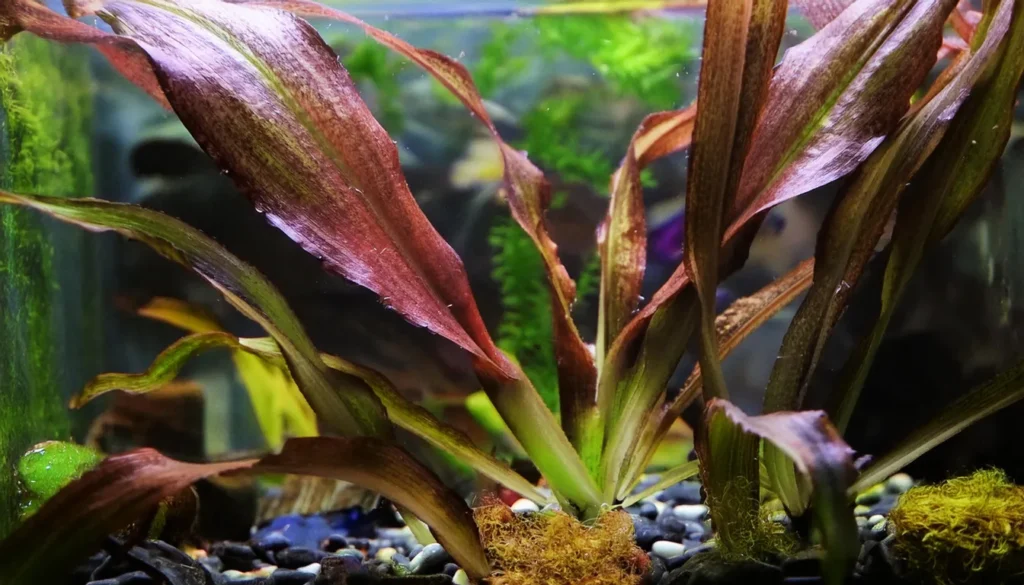
Recommended Tank Size
- For Individual Specimens: If you plan to keep a single specimen or a small group of Echinodorus Red Flame plants, a tank size of at least 10 gallons (approximately 38 liters) can be suitable. This size provides enough space for the plants to spread their leaves and develop a strong root system.
- For Dense Plantings: If you aim to create a dense planting of Echinodorus Red Flame or include multiple specimens, consider a larger tank. A tank size of 20 gallons (approximately 75 liters) or more would provide ample space for a lush display of these plants without overcrowding.
- Consider Overall Layout: When selecting a tank size, consider the overall layout and design of your aquarium. Ensure that there is enough space in the background or mid-ground of the tank to accommodate the size of Echinodorus Red Flame plants and their growth habits.
- Compatibility: Take into account the needs of other inhabitants in the aquarium, such as fish and invertebrates. Choose a tank size that accommodates the requirements of all species and provides enough swimming and hiding space.
Complementary Plants For A Vibrant Aquascape
Enhance the vibrancy of your aquascape by selecting complementary plants to accompany your Echinodorus Red Flame.
Consider plants with contrasting foliage colors, textures, and shapes to create an eye-catching ensemble.
The combination of vibrant red foliage from the Echinodorus Red Flame and other complementary plants will create a visually appealing and captivating aquascape.
Some examples of complementary plants for a vibrant aquascape with Echinodorus Red Flame include:
- Anubias Nana, with its lush green leaves and compact size
- Hemianthus Callitrichoides (Dwarf Baby Tears) for a carpet-like effect
- Rotala rotundifolia, with its delicate red stem and contrasting foliage
- Java Fern, with its unique leaf shape and distinctive texture
RELATED: How To Plant Ceratopteris Siliquosa In Your Aquarium?
Nutritional Needs
Meeting the nutritional needs of Echinodorus Red Flame (Echinodorus horemanii “Red”) is essential for its growth, coloration, and overall health. Here are the key nutritional requirements to consider:
Macronutrients
- Nitrogen (N): Essential for chlorophyll synthesis and overall plant growth.
- Phosphorus (P): Important for energy transfer, root development, and flower production.
- Potassium (K): Facilitates enzyme activation, osmoregulation, and overall plant vigor.
Micronutrients
- Iron (Fe): Necessary for chlorophyll production and enzymatic processes.
- Magnesium (Mg): Component of chlorophyll molecules, essential for photosynthesis.
- Calcium (Ca): Important for cell wall structure and overall plant integrity.
- Other micronutrients: Including but not limited to zinc (Zn), copper (Cu), manganese (Mn), boron (B), and molybdenum (Mo), which are required in trace amounts for various physiological processes.
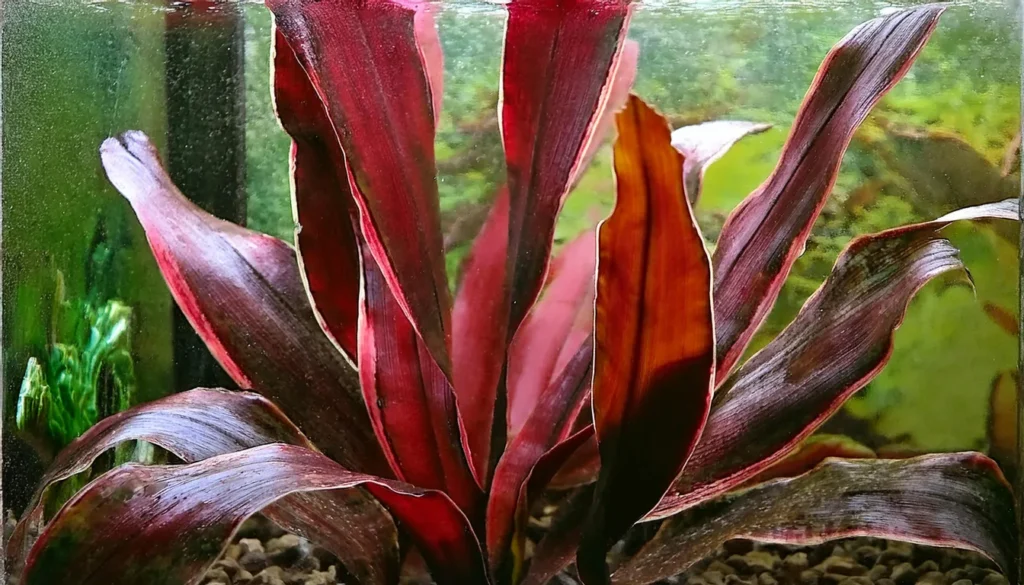
Cultivation Tips For Echinodorus Genus
- Lighting: Provide moderate to high lighting levels suitable for the growth of Echinodorus plants. Aim for around 8 to 10 hours of light per day, using full-spectrum LED or fluorescent lights with a color temperature around 6500K.
- Substrate: Use a nutrient-rich substrate specifically designed for planted aquariums. Echinodorus plants benefit from a substrate that provides essential nutrients to support healthy root development and overall growth.
- CO2 Injection: Consider supplementing your aquarium with CO2 injection to enhance plant growth, especially in high-tech planted tanks. CO2 supplementation can promote lush growth and vibrant coloration in Echinodorus species.
- Fertilization: Provide regular fertilization to ensure the plants receive all essential nutrients for healthy growth. Use a comprehensive liquid fertilizer formulated for aquarium plants and follow the dosage instructions carefully to prevent nutrient deficiencies or imbalances.
- Water Parameters: Maintain stable water parameters within the recommended range for Echinodorus plants. This includes temperature, pH, hardness, and nutrient levels. Regular water changes and monitoring of water parameters are essential for plant health.
Propagation Tips
- Rhizome Division: Separate the rhizome into sections with healthy roots and leaves, then plant them separately.
- Separation of Plantlets: Wait for plantlets to develop roots and leaves, then carefully separate them from the parent plant and replant.
- Leaf Cuttings: Select healthy leaves and cut them into sections, then plant them in the substrate to encourage new growth.
- Provide Optimal Conditions: Ensure the propagated plants have adequate lighting, nutrient-rich substrate, and stable water parameters.
- Be Patient: Propagation may take time, so monitor the growth and provide regular care as needed.
- Trim and Maintain: After propagation, trim any damaged leaves and maintain proper care to ensure healthy growth.

Role Of Echinodorus Red Flame In The Aquarium Ecosystem
- Echinodorus Red Flame plays a vital role in the aquarium ecosystem. These plants contribute to oxygenation in the water as they release oxygen through photosynthesis.
- They also assist in water filtration by absorbing excess nutrients, which can help maintain water quality. Additionally, the presence of Echinodorus Red Flame provides hiding places and shelter for fish and other aquatic creatures.
Which Tropical Fish Species Thrive With Red Flame?
Echinodorus Red Flame is a versatile plant that can coexist harmoniously with various tropical fish species in community tanks.
Its vibrant red foliage provides an attractive and natural environment for a diverse range of fish. Some tropical fish species that thrive alongside Echinodorus Red Flame include:
- Tetras
- Gouramis
- Livebearers
- Rasboras
- Dwarf Cichlids
- Corydoras Catfish
Conclusion
When it comes to adding a touch of vibrancy to your planted tank, Echinodorus Red Flame is the perfect choice.
This captivating aquatic plant features striking red foliage that instantly becomes the focal point of any aquarium.
Its adaptability and aesthetic appeal have made it a favorite among aquarists.
With proper care, placement, and maintenance, Echinodorus Red Flame can thrive and enhance the visual impact of your freshwater aquarium.
Ensuring adequate lighting, nutrient-rich soil, and regular fertilization are essential for its growth and overall health.
Not only does Echinodorus Red Flame add beauty to your tank, but it also serves a functional role in the aquarium ecosystem.
By releasing oxygen through photosynthesis and absorbing excess nutrients, it contributes to water oxygenation and filtration.
Additionally, it provides a natural habitat for fish and other aquatic creatures, offering hiding places and shelter.
Frequently Asked Questions
How Can I Enhance The Red Coloration In Echinodorus ‘red Flame’ Leaves?
Enhancing the red coloration in Echinodorus ‘Red Flame’ involves optimizing lighting and nutrient supply. High-intensity lighting with a good balance of red and blue spectrums encourages the development of red pigments.
Iron supplementation is crucial; iron deficiency can lead to pale colors, so ensure your fertilization routine includes chelated iron.
Additionally, maintaining a slightly acidic pH helps the plant absorb nutrients more efficiently, further intensifying leaf coloration.
What Are The Optimal Water Parameters For Promoting Vigorous Growth In Echinodorus ‘red Flame’?
Echinodorus ‘Red Flame’ thrives in water temperatures between 22°C to 28°C (72°F to 82°F), with a pH range of 6.5 to 7.5 and soft to medium hardness (3-12 dGH). Consistent water quality, achieved through regular water changes, supports healthy growth.
Slight fluctuations within these ranges are tolerable, but avoid drastic changes that can stress the plant.
How Does Substrate Choice Impact The Growth And Health Of Echinodorus ‘red Flame’?
The substrate is crucial for the robust root system of this plant
A nutrient-rich, fine-grained substrate allows for easy root penetration and access to essential nutrients. Incorporating a layer of laterite or using root tabs can provide an iron-rich environment, encouraging vibrant growth and coloration.
Ensure the substrate depth is adequate (at least 3-4 inches) to accommodate the extensive root system.
Can Echinodorus ‘red Flame’ Be Propagated In Home Aquariums, And What Is The Best Method?
Yes, Echinodorus can be propagated by adventitious plantlets that form on the inflorescence (flower stalk). Once these plantlets have developed roots and a few leaves, they can be carefully detached and planted in the substrate.
This method allows aquarists to expand their collection or share with others while maintaining the genetic characteristics of the parent plant.
What Advanced Techniques Can Be Used To Manage And Prevent Common Pests Or Diseases In Echinodorus ‘red Flame’?
Preventing pests and diseases in Echinodorus ‘Red Flame’ begins with quarantine procedures for new plants and regular health inspections. For pests like snails or algae, manual removal or introduction of natural predators (certain fish or invertebrates) can be effective.
Diseases often stem from poor water quality or nutrient imbalances, so maintaining clean water and balanced fertilization is key.
In the case of fungal infections, removing affected leaves and treating the water with a safe, aquarium-specific fungicide can help manage outbreaks.
Always isolate affected plants to prevent the spread of pests or diseases.
- Unveiling The Wonders Of Riccia Fluitans In Aquascapes - August 7, 2024
- Vallisneria Gigantea Var. Guide To Care And Cultivation At Home - July 31, 2024
- Vesicularia Dubyana Care & Growth Guide Tips For Beginner Gardeners - July 30, 2024
